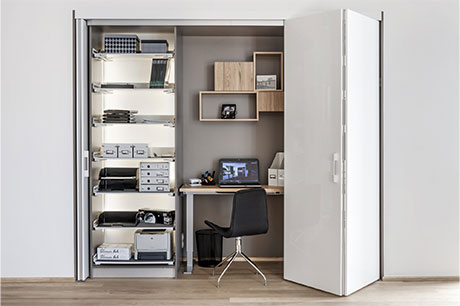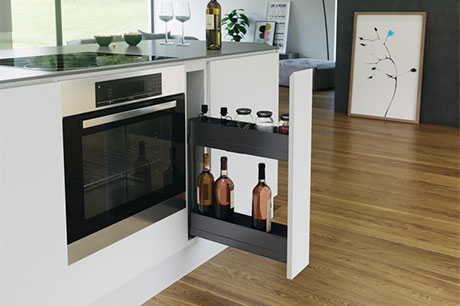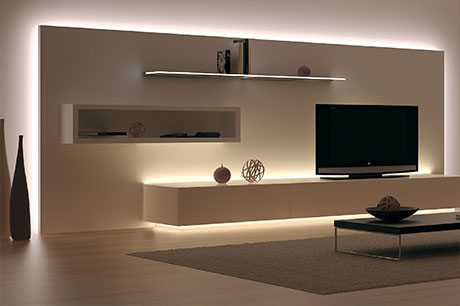Compact Living Layouts: Product Guide
Layout is the starting point when working out how to create a functional space, especially when the space itself is at a premium.

Compact living has become a lifestyle choice for some, and a necessity for many, as our recent report demonstrated. This creates a huge opportunity for designers, manufacturers and retailers alike.
Whether it’s new ideas for a combined kitchen-dining-living space in a small apartment, or knocking walls down in a family home to enable the household to come together for different activities, certain products and designs lend themselves well to compact properties.
Broken-plan, where a larger area is broken into different zones using fixtures, fittings and furniture, is a great way to split space for different purposes. Over 40% of respondents in our Functional Spaces: Kitchens for Living research said they felt broken-plan was a better use of space than the more traditional open-plan layout. However, a third said they wouldn’t know how to create different zones.
Sliding doors are an effective way to change the use of space and can also be used to close off certain areas when they’re not needed. Whether it’s shutting away a playroom when the kids have gone to bed, or hiding the washing up from view, physical divides are a great way to help homeowners to destress, as well as move from one activity to the next during the day and night. Because sliding doors save around 1m of floor space compared to swing-out alternatives, they’re perfect for compact living. In particular, pocket doors – which slide back into an existing recess within a wall – take up even less room.
Flexible furniture for compact living
With the right fittings and fixtures, more traditional furniture designs can be transformed into multi-functional innovations. Many of us will be familiar with dining room tables that can extend for larger gatherings, or can be folded away against the wall when not in use, but there are almost endless possibilities when you start piecing together different manufacturing and design items.
For example, with a mechanism that enables worksurfaces to rise you could create a coffee table that can transform into a desk for working from home. You could also use such fittings to create pop-out features, such as a TV that can be hidden away in a cabinet or a coffee machine that can be stored underneath a kitchen worktop when not in use.
Pivot doors or Tambour Door fittings are also a great way of creating different ‘stations’ around the home, such as a hidden home office, breakfast bar or vanity unit without taking up much space and able to fit into even the smallest of spaces.

Super storage
Whichever room you’re designing or renovating, storage should be a key consideration. In our Functional Spaces: Kitchens for Living research, badly designed storage and limited space were among homeowners’ top kitchen bug bears. Nearly a third (32%) said they didn’t have enough storage and 17% said their storage is located too high for them to reach.
When space is at a premium, every centimetre counts. Sliding door gear, hinges and other fittings can help to create valuable storage in otherwise forgotten or unused spaces. For example, furniture such as sofas where the seats can lift to create ottoman-style storage or even concealed pockets in the armrests are useful in living rooms. The areas under the stairs and in alcoves can also be transformed into useful cupboards and drawers too.
Stylish, strong and slim hinges and flap fittings are an effective way to maximise the amount of usable space in storage while balancing it with a premium look and feel.
Compact living: Room-by-room guide
While layout and storage are two key considerations when it comes to compact living, there are different design ideas for specific rooms.
Kitchens
In our research, we found one in ten people admitted to downgrading the internal wirework storage installed in their cupboards, however more than one in five would shop around next time they buy a kitchen to get the best functionality for their budget. Whether pull-out larders or swing-out corner storage, what goes into a cupboard can help to maximise the usable space within the unit. And to make use of the whole height of a kitchen, you can look at introducing pull-down wirework in cupboards and shelves to avoid having to stand on chairs or lean on worktops to reach up.
Concealed bins can be installed into narrow cupboard spaces to save on floor space and you can even make use of otherwise forgotten places like plinths, with under-cabinet plinth drawers or install a plinth vacuum.
Consider using very narrow spaces between units and the wall for wine racks, spice cupboards or to hang tea-towels. You can also get smaller and narrower appliances to help fit more into smaller kitchens.

Living Room
Storage units that conceal and hide away large devices when they’re not in use such as TVs, games consoles or music players help to create a clutter free space. Built-in shelving units and cupboards, particularly in narrow or awkward alcoves or gaps, can also provide valuable storage areas. Or, they can double up as home offices with compact fittings and Hawa Concepta doors to conceal the space when not in use.
LED lighting strips can help to create different moods and give the illusion of space depending on the colour and brightness, helping you to provide customers with lighting schemes which offer a cosy atmosphere for relaxing in the evening, or a bigger and brighter space for working or socialising during the day.
Bathrooms
Layout in small bathrooms and ensuites is very important.
Storage hung to the walls, heated towel rails, and Bluetooth-enabled mirrors that double up as cabinets are also popular compact living design trends for the bathroom or ensuite.
To save even more space, consider adding a sliding or pocket door instead of a traditional door to get in and out of the bathroom or ensuite as this will open up more layout and space opportunities.
Bedrooms
Foldaway beds are the perfect way to instantly free up room when space is tight. With different sizes and weights available, they are a great space-saver for smaller rooms. Another option is to use a daybed or guest bed which acts as either a single bed or sofa during the day, but can extend out to provide additional sleeping space.
Wardrobes and cupboards with sliding or pocket doors help to maximise storage space, and you can also consider creating a multi-purpose area that acts as both a dressing table and compact home office space.
Whichever room or type of compact area you’re working on, there are a variety of products and services on offer from Häfele to help you make the most of every bit of space available.










